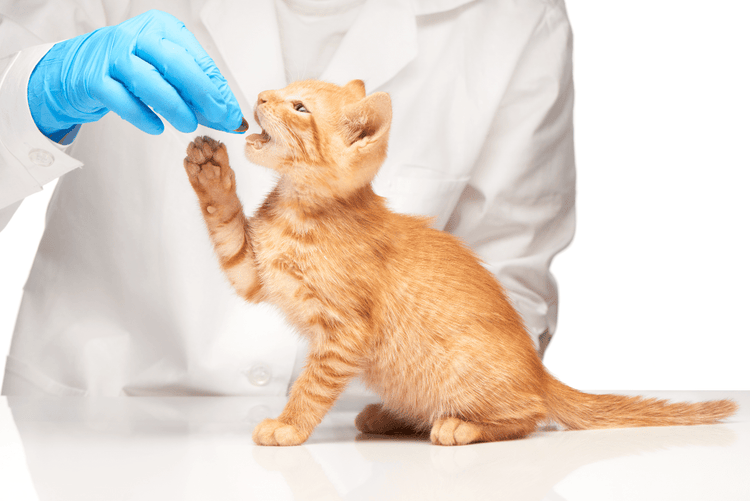
Flunixin (Banamine®) for Dogs and Cats
Flunixin, commonly known as Banamine®, belongs to a general class of drugs known as non-steroidal anti-inflammatory drugs (NSAIDs). It is a commonly prescribed drug used to treat pain and inflammation associated with arthritis and other musculoskeletal disorders in dogs and cats. Other related drugs in this class include aspirin, ibuprofen, ketoprofen, and naproxen. These drugs are capable of reducing pain fever, and inflammation. This drug can be used in dogs, however is uncommonly recommended by most veterinarians.
Flunixin’s chemical name is 2-(2-methyl-3-trifluoromethylanilino) nicotinic acid.
How Does Flunixin Work?
NSAIDs, like flunixin, work by inhibiting formation of body chemicals called prostaglandins. In modulating the inflammatory response, these drugs reduce redness, swelling, heat, and pain associated with tissue damage. It also has antipyretic activity.
Flunixin’s clinical effect is apparent \~ 15 minutes after intravenous injection and 1-2 hours after intramuscular injection
Brand Names for Flunixin
This drug is registered for use in horses and cattle only.
- Human formulations: None
- Veterinary formulations: Banamine® [a.k.a. Finadyne®] (Schering-Plough), AmTech Flunixin Meglumine® (Phoenix Scientific), Equileve® (Vetus), FluMeglumine® (Phoenix Pharmaceuticals), Flunixamine® (Ft. Dodge), Flunixin Meglumine [generic] (Butler).
Flunixin meglumine (50 milligram/milliliter) is supplied in 100 milliliter and 250 milliliter bottles. Flunixin is also available as an oral paste or in a granular form, but these preparations are rarely used in small animal practice.
Uses of Flunixin for Dogs and Cats
Flunixin is primarily used to treat pain and inflammation associated with arthritis and other musculoskeletal disorders. It is also used for the following purposes:
- To reduce pain associated with various surgical procedures.
- To combat intraocular prostaglandin release pre- and post ophthalmic surgery
- To decrease a fever.
- As a component in the treatment of shock, particularly endotoxic shock in dogs.
- As a topical anti-inflammatory agent in the treatment of acral lick dermatitis.
Flunixin for Dogs and Cats: Precautions and Side Effects
While generally safe and effective when prescribed by a veterinarian, flunixin can cause side effects in some animals. The most common adverse effects associated with flunixin are vomiting, diarrhea, lethargy, and lack of appetite.
Flunixin should not be used in animals with known hypersensitivity or allergy to the drug. Great caution should be exercised if there is a history of untoward effects caused by using other NSAID’s. The drug should also be avoided in animals with liver, kidney, heart, blood abnormalities, gastrointestinal disorders, or kidney impairment.
Flunixin may interact with other medications. Consult with your veterinarian to determine if other drugs your pet is receiving could interact with flunixin. Such drugs include aspirin, other NSAIDs, corticosteroids, warfarin, heparin, and aminoglycoside antibiotics, such as gentamicin and amikacin.
Dosage Information for Flunixin in Dogs and Cats
In dogs, flunixin is dosed at 0.25 to 1.2 milligrams per pound (0.5-2.2 milligram/kilogram) intravenously (IV) every 24 hours (typically for no more than 3 days). Flunixin can also be administered at the lower end of this range (i.e. 0.125 to 0.25 milligram per pound [0.25-0.5 milligram/kilogram]) IV every 12 hours for 1 – 3 treatments.
For topical use on acral lick lesions, 3 milliliter of flunixin can be mixed one bottle of Synotic® and applied to the lesion two to three times daily.
In cats, flunixin is dosed at 0.125 milligram per pound (0.25milligram/kilogram) IV once, or every 24 hours for two doses.
The duration of administration of this medication depends on the condition being treated, response to the medication, and the development of any adverse effects. Be certain to complete the prescription unless specifically directed by your veterinarian. Even if your pet appears to be doing better, the entire treatment plan should be completed to prevent relapse.
Medication should never be administered without first consulting your veterinarian.